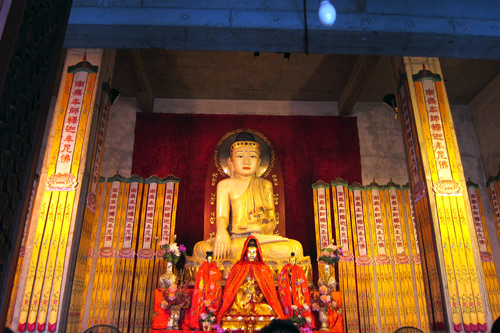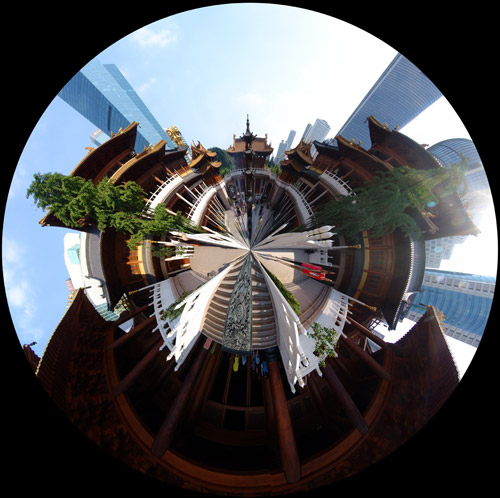A Visit to Jing’an – a Mecca for Leophiles?
Unlike Beijing, which tends to have a strong history in which it continuously wallows, Shanghai is much less endowed with old buildings and historic sites. Not that they can’t be found, of course, but it’s just that there are much fewer of them.
One old Buddhist temple that most definitely is on the tourist beat, however, is on West Nanjing Road just a stone’s throw from a metro station on line 2 that bears its name.
Jing'an Temple (静安寺) sits on one of the busiest roads in Shanghai, in one of the city’s business districts that also contains several luxurious residential complexes and “boasts” (if that’s the right word) an extremely vibrant nightlife. An Art Deco "dancehall" is just across the street, while neighbouring roads are stuffed full of cafes and bars. Some have remarked that this area is China's equivalent of New York's 5th Avenue. The local park round the corner used to be old Shanghai’s graveyard in which expatriates got buried! Ironically, Jing'an means tranquil and peaceful!
You’ll know you’re at this temple well before you see the entrance. Gold lions smile down at you from every vantage point. The whole place looks dead impressive … from the outside!
Inside, it’s a different story. The temple is diminutive in size when compared to others around the country, but it’s still nice to visit, albeit that your stay will be a lot shorter…
The temple appears much younger than its true age - unsurprisngly. Originally built in the 3rd century Wu State (222-280) north of the Wusong River, it was moved to its present site in 1216 during the Song Dynasty in order to protect it from flooding. It was destroyed in 1851, rebuilt during the reign of Emperor Guangxu (1875-1908), turned into a plastics factory during the Cultural Revolution, burnt to cinders in 1972, reconstructed after 1984, and finally opened to the public again in 1990. Most of the recent remodelling has been done with Burmese teakwood. And that’s its problem – it all looks too new and somewhat soulless.
Nonetheless, every April 8th, the birthday of Sakyamuni, there’s a temple fair which lasts for three days. Apparently “Tranquil and peaceful” are not words that spring to mind at that time!
In the centre of the first courtyard is one of those large tripod-shrine-like-thingies in which people burn joss sticks or paper and try to throw coins into the upper reaches for good luck. Anyone short of a bob or two and a tad of patience could make a small fortune here going around collecting the discarded coins. But of course, that would bring bad luck and is therefore NOT TO BE RECOMMENDED!
The lion theme is continued at the base of the “thingie” – as it is on various stone plaques dotted around the place…
whilst dragons can be seen accompanying you up the stone staircases into the first hall.
Yet more animals greet you on the wooden doors – this time some rather cute elephants (can elephants be cute I wonder?)…
One of the prized sections of this temple is the Mahavira Hall (大雄宝殿) which was completed in 1991. Here there’s a Jade Buddha, 3.8-metres high and brought over from Burma (or Mayanmar as we’re apparently supposed to call it these days) – apparently the largest sitting jade Buddha statue in mainland China.
It weighs in at 11,000 kilograms and is so big that a wall was torn down to get it in. The statue was made according to the style of traditional Han Buddhists, whereby the face was shaped like a full moon and the expression was “tender and serene”.

In 2009, an additional statue of Tathagata made from 15 tons of silver, 8.8 metres high was also placed in the temple.
To the east of the main hall is the Guanyin Hall in which you can find a statue of the Goddess of Mercy made out of one piece of thousand-year-old camphor wood, standing on a lotus-shaped base. it is 6.2 metres tall and weighs 5 tons.
But I’m afraid I’m a sucker for portly, rotund statues of Buddha. They always appear so happy, unlike some of the other po-faced Buddha statues …
There’s also a collection of Arhats soaking up the rays of the overhead fluorescent lighting
and lest they get bored, they can stare at some rather cute painted panels running along the opposite wall.
As I said, not a huge amount to see, but quite interesting in its own way. I doubt I will rush back to Jing’an if ever I return to Shanghai, but I’m glad I went.

